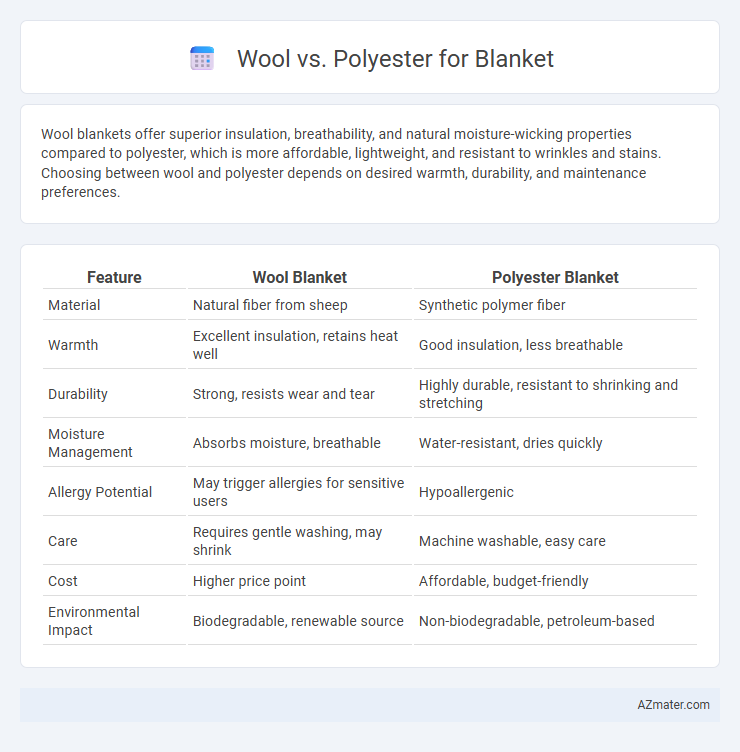Wool blankets offer superior insulation, breathability, and natural moisture-wicking properties compared to polyester, which is more affordable, lightweight, and resistant to wrinkles and stains. Choosing between wool and polyester depends on desired warmth, durability, and maintenance preferences.
Table of Comparison
| Feature | Wool Blanket | Polyester Blanket |
|---|---|---|
| Material | Natural fiber from sheep | Synthetic polymer fiber |
| Warmth | Excellent insulation, retains heat well | Good insulation, less breathable |
| Durability | Strong, resists wear and tear | Highly durable, resistant to shrinking and stretching |
| Moisture Management | Absorbs moisture, breathable | Water-resistant, dries quickly |
| Allergy Potential | May trigger allergies for sensitive users | Hypoallergenic |
| Care | Requires gentle washing, may shrink | Machine washable, easy care |
| Cost | Higher price point | Affordable, budget-friendly |
| Environmental Impact | Biodegradable, renewable source | Non-biodegradable, petroleum-based |
Introduction: Wool vs Polyester Blankets
Wool blankets offer natural insulation, moisture-wicking properties, and breathability, making them ideal for regulating body temperature in various climates. Polyester blankets, constructed from synthetic fibers, provide durability, affordability, and ease of maintenance, often resisting wrinkles and stains. Understanding the differences in fiber composition and performance helps consumers choose blankets suited to their comfort, durability, and care preferences.
Key Differences Between Wool and Polyester
Wool blankets offer superior insulation and moisture-wicking properties due to their natural fibers, making them ideal for regulating body temperature in both warm and cold conditions. Polyester blankets, made from synthetic fibers, provide enhanced durability, stain resistance, and affordability, but they lack the breathability and hypoallergenic benefits of wool. The choice between wool and polyester blankets depends on preferences for natural material advantages versus cost-effective and easy-care synthetic options.
Warmth and Insulation Comparison
Wool blankets provide superior warmth and insulation due to their natural fibers that trap heat effectively while allowing breathability, making them ideal for cold climates. Polyester blankets offer decent insulation by repelling moisture and retaining heat but tend to be less breathable, which can cause overheating. Wool's ability to regulate temperature and wick away moisture makes it the preferred choice for consistent warmth and comfort compared to polyester.
Breathability and Moisture Management
Wool blankets excel in breathability and moisture management due to their natural fiber structure, which allows air circulation while wicking away moisture, keeping users dry and comfortable. Polyester blankets, made from synthetic fibers, generally trap heat and moisture, leading to reduced breathability and a damp feeling during extended use. Wool's superior moisture-wicking capabilities and temperature regulation make it a preferred choice for breathable, moisture-managing blankets.
Durability and Longevity
Wool blankets offer exceptional durability due to their natural elasticity and resistance to wear, often lasting decades with proper care. Polyester blankets, while less expensive, tend to degrade faster due to synthetic fibers prone to pilling and fiber breakage over time. The longevity of wool surpasses polyester as it maintains warmth, shape, and texture even after extensive use and washing.
Comfort and Texture
Wool blankets offer superior breathability and natural moisture-wicking properties, providing a cozy and temperature-regulating comfort ideal for cooler climates. Polyester blankets feature a smooth, soft texture with lightweight warmth, making them hypoallergenic and easy to maintain. The tactile experience of wool is slightly coarse but becomes softer with use, while polyester delivers consistent plushness and durability.
Allergenicity and Skin Sensitivity
Wool blankets are naturally hypoallergenic and resistant to dust mites, making them ideal for individuals with allergies or sensitive skin. Polyester blankets, while less breathable, can sometimes cause irritation or exacerbate skin sensitivities due to synthetic fibers and chemical treatments. Choosing wool reduces the risk of allergic reactions and skin discomfort, providing a more comfortable and healthier option for sensitive users.
Eco-Friendliness and Sustainability
Wool blankets excel in eco-friendliness due to their natural, biodegradable fibers and renewable source, as sheep are shorn annually without harm. Polyester blankets, made from synthetic petroleum-based fibers, contribute to microplastic pollution and require significant fossil fuel consumption, impacting sustainability negatively. Wool also offers superior biodegradability and carbon sequestration properties, making it a more sustainable choice for environmentally conscious consumers.
Care and Maintenance Requirements
Wool blankets require delicate care, including gentle hand washing or dry cleaning to prevent shrinking and maintain fiber integrity, while avoiding high heat during drying to preserve softness. Polyester blankets offer easier maintenance with machine washability, quick drying, and resistance to wrinkles and shrinking, making them a practical choice for everyday use. Choosing wool ensures natural breathability and warmth but demands more careful handling, whereas polyester provides durability and convenience with minimal upkeep.
Price and Value for Money
Wool blankets generally come with a higher price tag due to the natural fibers and insulating properties, offering exceptional warmth and durability. Polyester blankets are more affordable, providing a budget-friendly option with easy maintenance but may lack the breathability and longevity of wool. Evaluating value for money depends on whether long-term comfort and natural quality outweigh initial cost savings.

Infographic: Wool vs Polyester for Blanket
 azmater.com
azmater.com